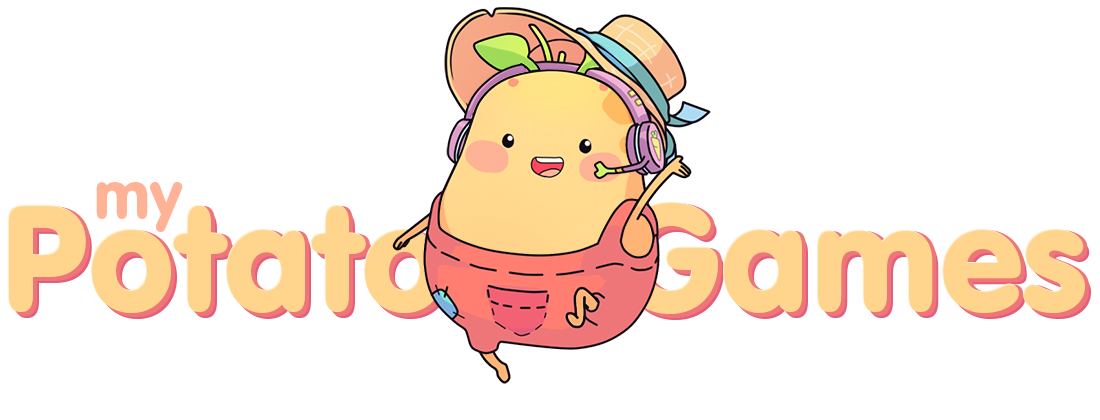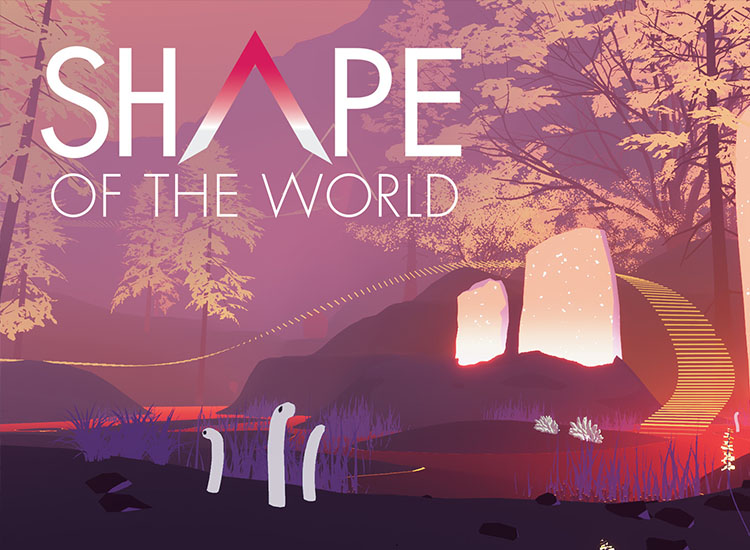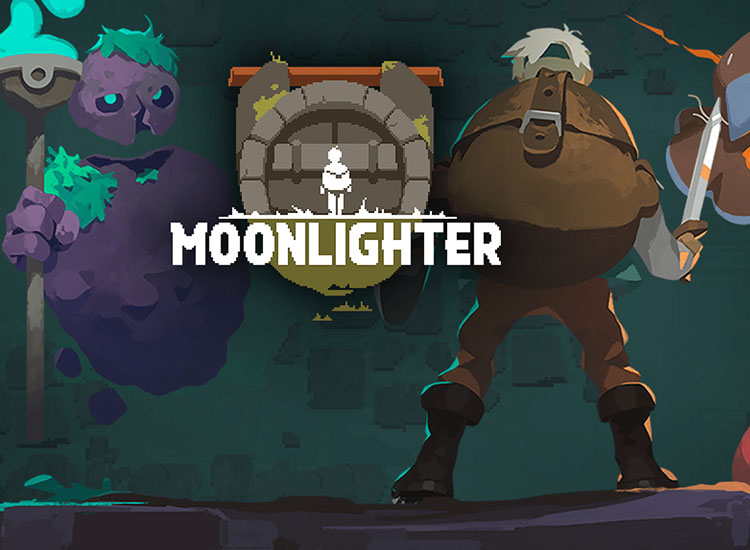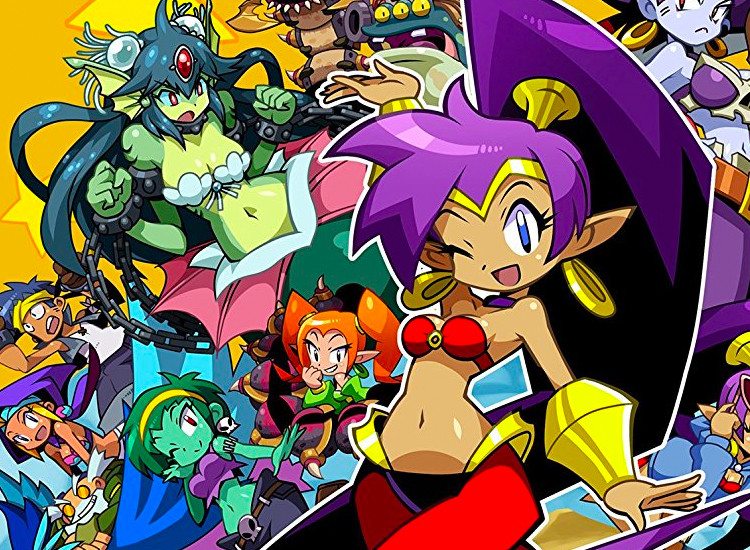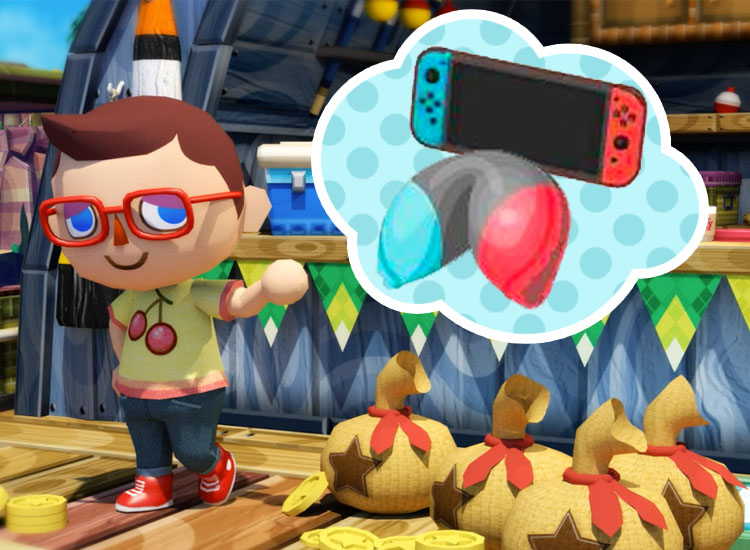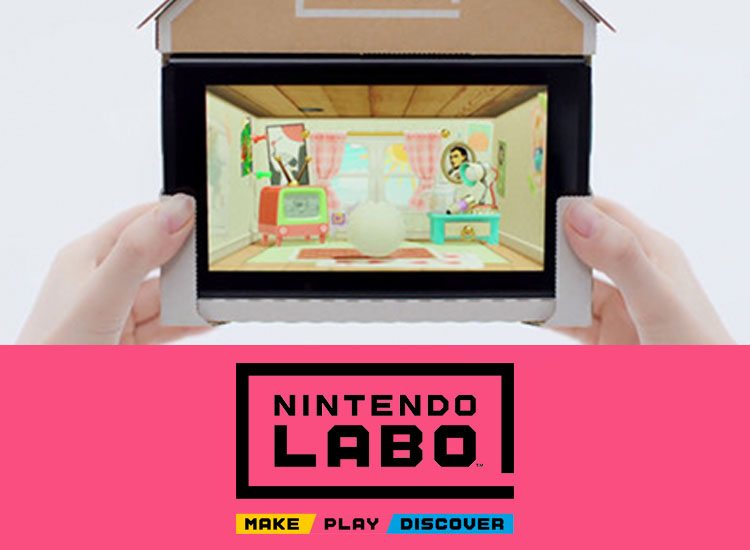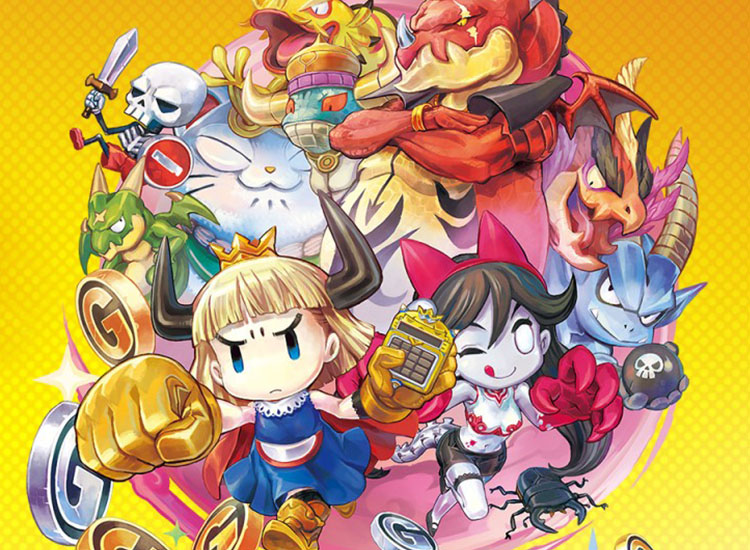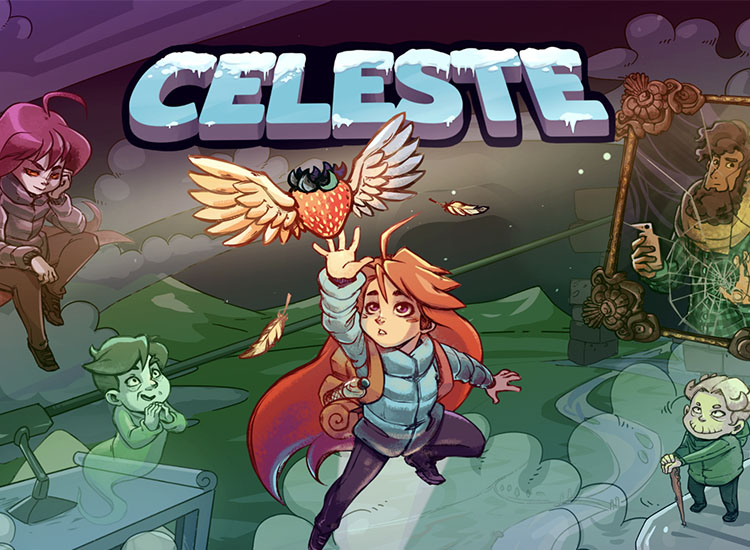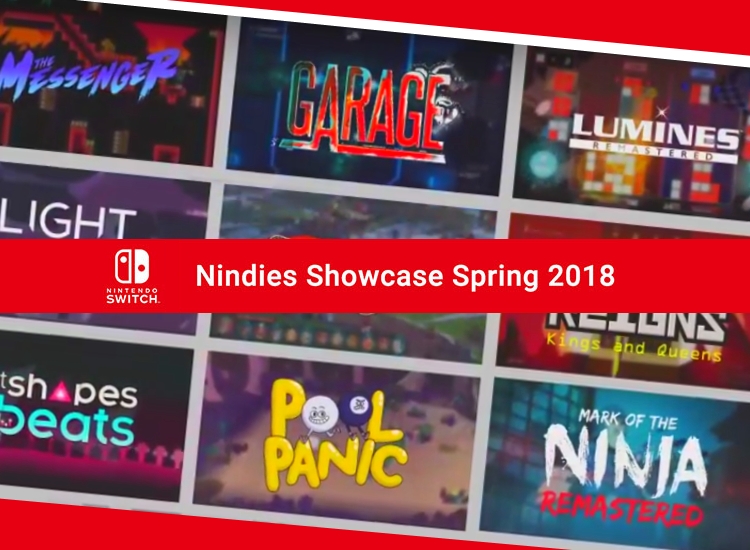Dylan
- Home
- Archive
Jun 8, 2018News
In a gaming climate full of lengthy and mechanically heavy experiences, there is always a place for a stress-free shorter experience. Shape of the World is a prime example of a title that trades out gameplay depth for a short, concise and relaxing gameplay adventure. Developed by Hollow Tree Games, Shape of the World is a first-person walking simulator adventure in which you explore a psychedelic and unknown world that comes to life around you. As you traverse through the world, the flora and landscapes materialise before you. It truly is a world of your own creation. It’s easy to compare Shape of the World to artistic gaming gems such as Journey, and despite not quite being as masterful, Shape of the World manages to provide a beautifully engrossing world that had me so heavily captured in its 1-3 hour runtime, that it freed me from the stresses and anxiety of reality.
If you were expecting a hearty narrative or any inkling of story in Shape of the World, sadly you’ll be disappointed. The lack of an established story leaves the interpretation of events for the player to mould, much like the games world. You awake in a world in a empty world devoid of colour, and from there the world is yours to shape. Storywise, there’s nothing given in Shape of the World, a reality that despite being upsetting, led to me making my own assumptions of what it all meant. Is it all a dream in which you form a world around you? Or are you possibly a god crafting your own shape of the world? It is interesting to theorise after all, and while I don’t particularly think it was a horrible choice to have no story, I do wish for more clarification was being made on what exactly is going on.

No story in sight, yet the world is still a beauty to explore
In terms of gameplay, your goal in Shape of the World is decidedly simple. You walk around in the world’s multitude of environments, bringing them to life, while locating triangles that once passed through, alters the environment as well as the colour of the world. As you walk through all the locales on your journey, such as mountains, swamps and caves full of water, you’ll find yourself in awe of the environments you are creating all around you. Tree’s spiral up from the ground in a multitude of different designs, tufts of grass emerge on the ground mere metres from where you’re about to stand, and a variety of alien creatures inhabit the land around you. The creatures on display range from weird floating blobs and jellyfish-like creatures, to animals such as fish and a hermit crabs. There’s even a giant pink whale that swims in the sky, if this game wasn’t odd enough already.
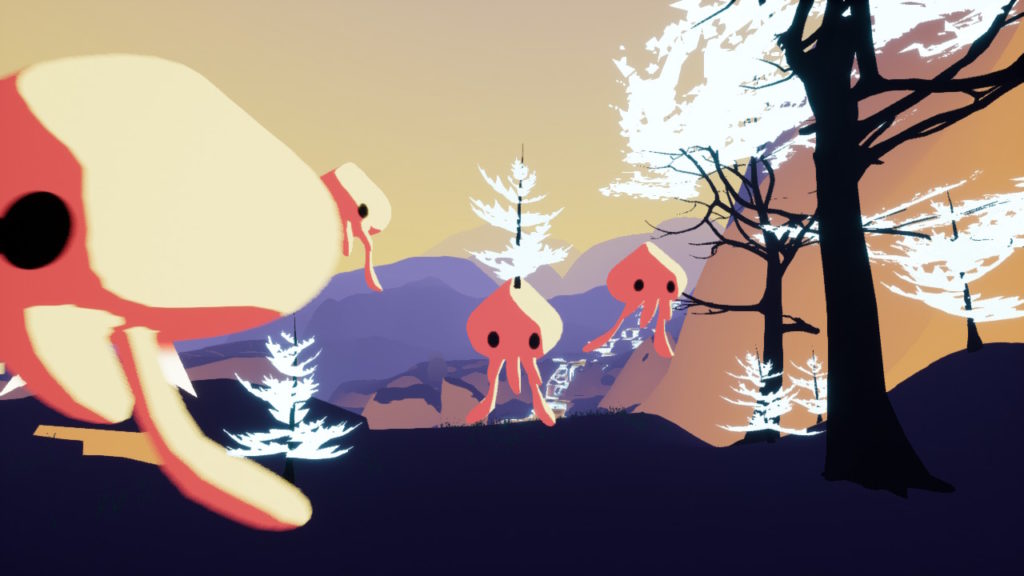
There are plenty of cute creatures to encounter on your travels
In the time between getting from each triangle checkpoint to the next, you’ll find yourself interacting with the flora and fauna of the world. Interacting with trees for example causes them to disappear, while also giving you a momentary momentum boost, allowing you to effortlessly glide throughout the ecosystem you’ve singlehandedly built. Interacting with the abundance of creatures lead to a variety of different results. Some creatures maintain regular activity, while the aforementioned jellyfish looking creatures shoot into the sky like rockets when they are touched.You can also find seeds scattered amongst the land, which when collected further change the colour scheme of the world, but also allow you to plant your own trees and other objects wherever you like. You don’t have to interact with everything in the world, but the curiosities always got the better of me.

So many lovely trees
There are puzzles in each area of the world, which involve actions such as interacting with a bunch of pillars to create a floating staircase, or touching a group of stalactites to raise the water levels in a cave. All of the puzzles essentially boil down to interacting with a bunch of glowing objects in the environment, and while I wish there was a bit more variety in puzzle design, the overwhelming urge to progress throughout the world in search for answers meant that I didn’t really mind the lack of creativity in the puzzles. The gameplay in Shape of the World is unashamedly minimalistic, and yet despite the lack of things to do other than simply interacting and exploring the environment around you, I still found myself deriving plenty of enjoyment from the gameplay on offer. At the end of the day, Shape of the World is meant to be an explorative adventure rather than a gameplay deep experience, and it should be treated as such.
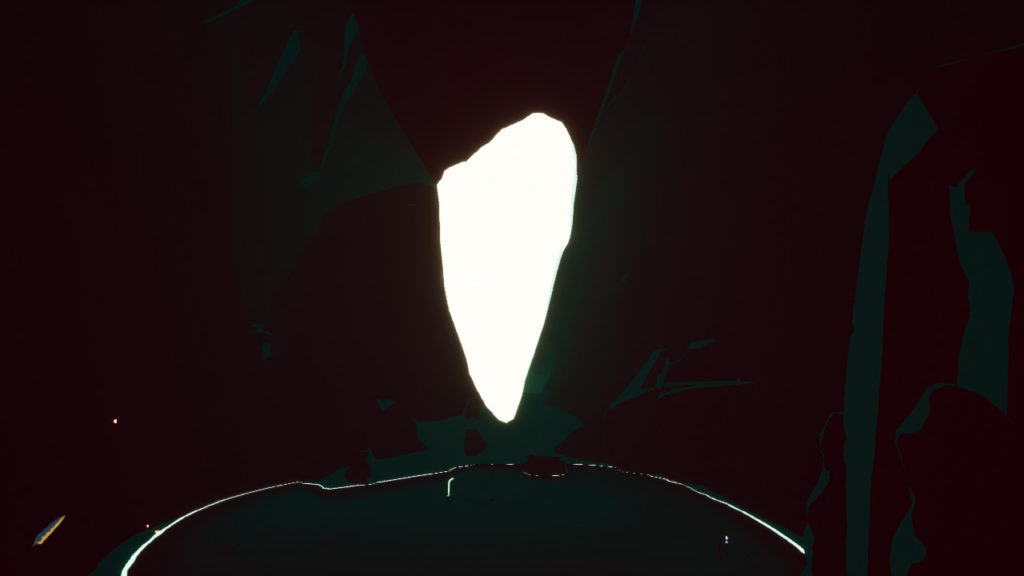
Puzzles involve interacting with glowing objects in the world
Also aiding in making the journey of Shape of the World so engaging is the constantly changing colour palettes that keep the world forever feeling fresh. The game looks jaw-droppingly gorgeous at all times, and although the artstyle can be a little disorienting initially, it’s one of the most attractive strings in Shape of the World’s bow. I found myself constantly taking in the view, as well as taking copious amounts of screenshots. The sound design is top notch also, with the game having a great soundtrack that expertly strengthens the dream-like atmosphere of the world.
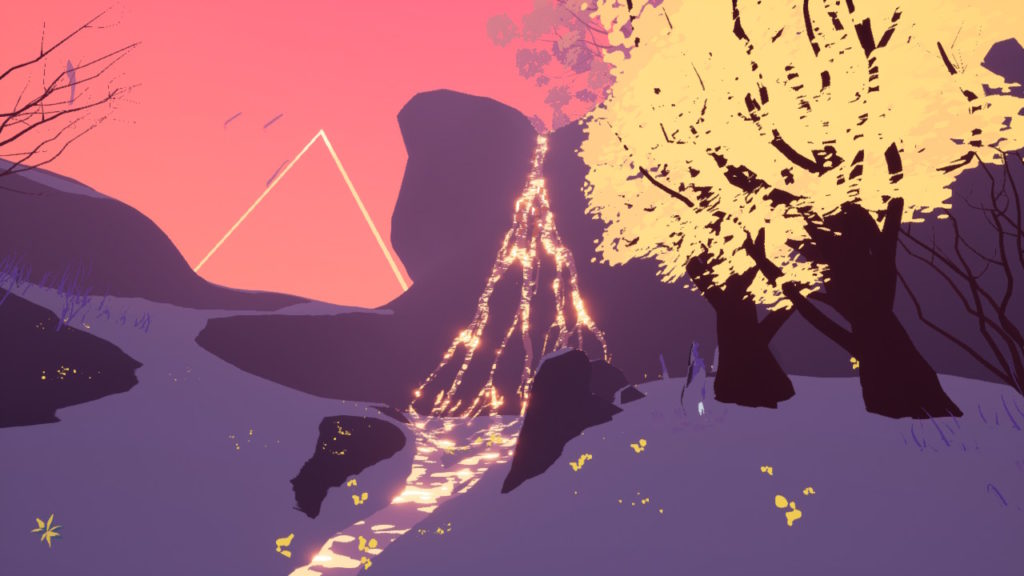
Even with the objective nearby, I always found myself taking in the view
Despite there being plenty of positives, I did run into a few issues with Shape of the World. I’m not sure if this issue appears in the PlayStation 4, Xbox One and PC versions, but on the Nintendo Switch version of the game I encountered numerous performance issues. The game was susceptible to heavy frame drops in small bursts, especially during the staircase sequences where your fast movement leads to the environment generating around you at a faster pace than usual. Sometimes there would be no loss of frames, while in other instances it would drop so heavily that the immersive spell that the game had me under was broken, which was disappointing. Another issue can be seen in the length of the game, as it only occupies around 1-3 hours of time. Yes, you can go back in a second playthrough and locate the seed collectables you may have missed in your initial run, but other than that, the game offers very little in regards to replayability.

The game is gorgeous, but occasional frame drops hurt the experience slightly
Overall, Shape of the World is a game that is sure to divide opinion. While many will be able to appreciate the artistry on display throughout the journey, I can envision others being miffed over the fact that the game overall lacks substance, with little to no gameplay other than meandering towards each goal, and no story present at all. If you’re a fan of the walking simulator genre of games or are after a short but sweet gaming experience, Shape of the World is a title for you. The world is beautiful, ever-changing and immersive, with the immersion further solidified in thanks to a miraculous soundtrack. The gameplay despite its simplicity does what it needs to in order for you to see the beauty of world you build, and even when you make your way towards the games conclusion, the ever-growing nature of the world meant that exploration always felt new and never stale. Shape of the World offers a psychedelic dream world brimming with otherworldly wonders, offering an explorative journey that I implore you to take.
Shape of the World was review on Nintendo Switch. Thank
Jun 6, 2018News
Moonlighter is a uniquely crafted game that expertly merges the rogue-lite action role playing of a game like The Binding of Isaac, with the simulation role playing of Stardew Valley. Comparisons aside, Moonlighter is very much its own beast, providing one of the most addicting gameplay loops in recent memory, alongside a bevy of mechanics and ideas that feel fresh and new.
By definition, a moonlighter is somebody who works an additional job after regular, full time employment at night. This is exactly the scenario that befalls Moonlighter’s protagonist Will. Will is a young merchant for the shop called Moonlighter in the village of Rynoka, a once thriving town that was built by those intrigued by the mysterious otherworldly dungeons nearby. The Dungeons as they are called in game, are portals to constantly changing locations, full of treasures and deadly creatures. As the village grew more and more greedy to snatch up all the sweet loot that these dungeons provided, they were closed, as too many lives were being lost. With the dungeons closed, the village struggled, turning many people away. Being the desperate merchant but also the gutsy adventurer, Will explores the depths of the dungeons, to gather loot to sell at his store to help bring the people back to Rynoka, while also living out his childhood dream of traversing through the mystical dungeons. In terms of story, this is all that Moonlighter really provides. Each dungeon has notes littered throughout that further explain the otherworldly nature of the dungeons, but besides that, the story of Moonlighter is yours to make.
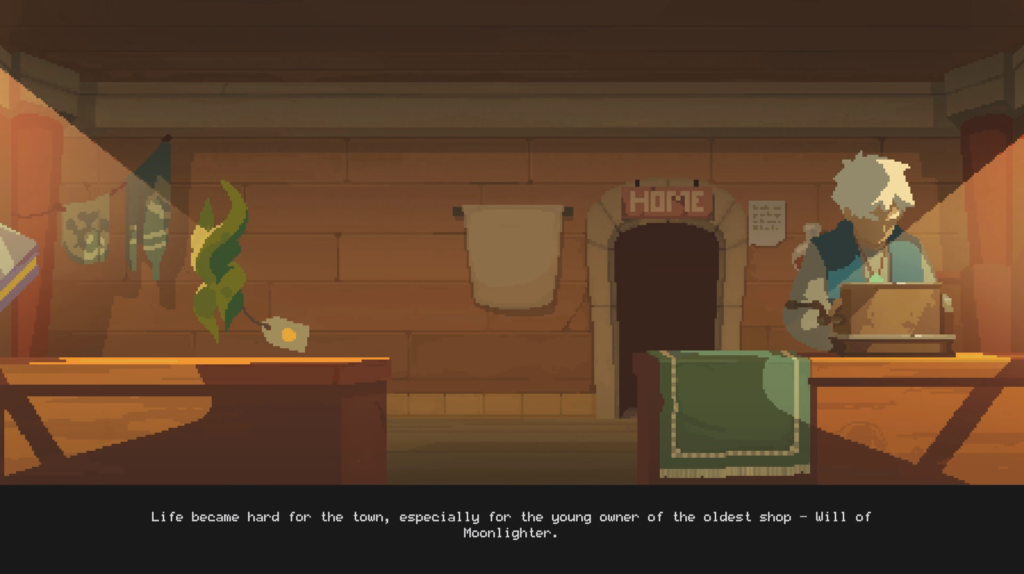
Introducing Will, the merchant of the Moonlighter
The gameplay of Moonlighter is split into two main parts, those being dungeon crawling and shopkeeping. Your daylight hours will be spent mainly running the Moonlighter, which involves selling the loot you have acquired from escapades in the worlds numerous dungeons. You can forgo your day work at the Moonlighter to explore the dungeons if you wish to do so, but dungeons aren’t as difficult throughout the day, leading to poorer quality of loot drops. For this reason I spent my days at the Moonlighter, and my nights in the dungeons.

Merchant by day, Loot Gatherer by night
Dungeons in Moonlighter are procedurally generated maps consisting of multiple rooms with varying enemies and types of loot to find, with the goal being to either make it to the end of the dungeon to kill the boss, or collect as much loot as possible before cleverly escaping the dungeon. As you make your way down the three floors of each dungeon on your way to the dungeon boss, you’ll spend your time engaged in combat with enemies, hacking and slashing away until the room is clear, before moving onwards to the next. For anyone that’s played 2D Zelda titles or The Binding of Isaac, you’ll know what to expect from the gameplay. You are initially awarded with a sword and shield, but you can also expect to craft and use other weaponry, such as big swords, bows, spears and gloves, all of which have their own pros and cons. Big swords for example are slow to attack with but pack a punch, while the spear allows for a greater attacking distance, at the expense of overall damage output. Enemies aren’t particularly difficult to take down, but they damage you so heavily if you aren’t cautious that death can come quickly, which isn’t ideal, as all items in your backpack will be lost. Thankfully, alongside his weapons, Will has a dodge roll that allows him to quickly evade attacks, a technique that is sure to aid you in sticky situations. The game even on hard wasn’t particularly difficult which is a shame, but I still found myself perishing on many occasions, forcing me to leave my loot behind.
Speaking of loot, there is plenty to find in each dungeon. Whether it be collected from dead enemies or pilfered from chests, you are bound to fill your backpack quite quickly. Having only 20 spaces for items leaves you with decisions to make as to what to keep and what to drop. This dilemma is further complicated when you begin to encounter cursed items, which are often rarer items that have negative effects on your inventory. Some cursed items can only be placed on the left and right hand sides of the inventory, while others may break if you take too much damage. The limited inventory space paired with the effects of cursed items leads to an interesting puzzle-game like battle when it comes to what you keep and what you leave behind.
Items collected can be sold immediately in dungeon through the use of the mirror (at a significantly reduced price), or can be held onto before leaving the dungeon. The problem is, leaving the dungeon costs a fee, unless you defeat the boss. The fee to use the pendant to leave the dungeon isn’t overly expensive, but upon returning to the dungeon, you start from the beginning. As your progress further in the opening hours, you are given another teleportation item called the catalyst, that for a far heftier sum than the pendant, allows you to go back to the Moonlighter with all your loot, before returning to where you were in the dungeon. This may appear to be a lot to take in, and it kind of is, but the premise is simple enough that it doesn’t take too long to understand what you need to do every time you go to the dungeons. At the end of the day it’s up for you to decide whether you want to play it safe and spend the gold required to leave the dungeon once you have enough loot, or progress further into the unknowns of the dungeon to defeat the boss and/or find better loot. It’s a savagely addicting cycle, but the constant decision making during each run leads to dungeons never feeling overly stale.
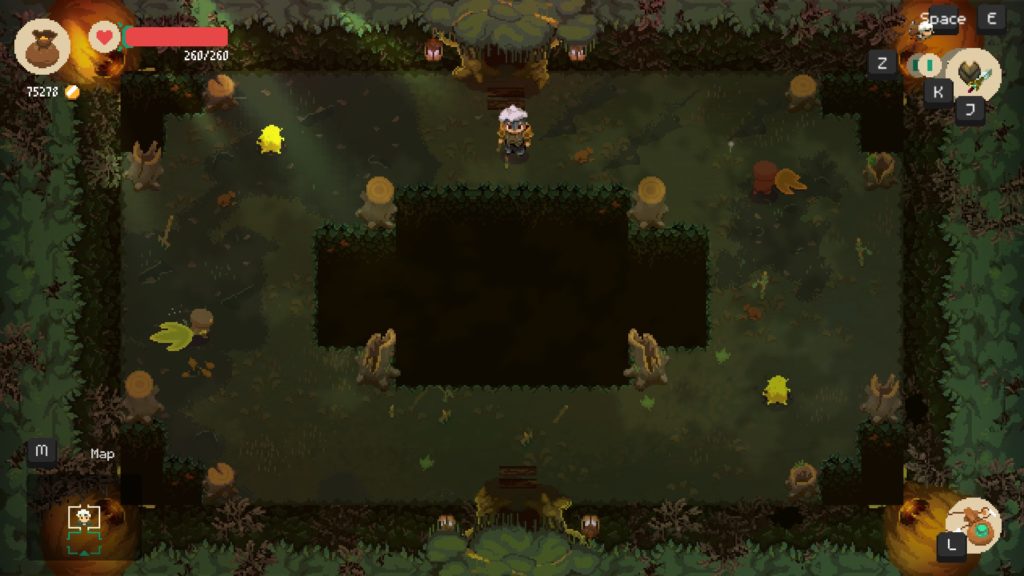
Dungeons are both pretty to look at and a joy to traverse
As mentioned previously, when you aren’t trying to defeat the bosses of dungeons and collecting and managing the copious amounts of loot you gather, you’ll spend your time selling your wares as the merchant of the Moonlighter. Selling items at the Moonlighter is a simple affair of placing your items on your sales tables, and pricing them at a price you deem appropriate for the item, however it’s a far more intricate system than that. The reaction of shoppers to the price tag of the item serves as a gauge as to whether an item is worth its sales price or not. If a customer is happy with the price, a simple happy face will appear above their head, and they will grab the item for you to complete the purchase, where as a disheveled sighing face will appear if the item is too expensive, causing them to look around for something else to buy or leave the store entirely.
If an item is priced too cheap, they’ll gleefully exhibit a coin-eyed emote, while if the item is slightly overpriced, they’ll display a reluctant emote, leading to the item being purchased, but the demand of the item decreasing overall. The key to selling items in the Moonlighter is to slap a price on something and see how the consumers react. The shopkeeping mechanics feel particularly interesting and enjoyable, and even after 20-30 hours of gameplay the process of pricing items to find a ideal price point feels refreshing and unique. Not going to lie though, seeing a customer glow with excitement after laying their eyes upon a great deal is heartbreaking, but it also puts you in good stead to better estimate your price the for the next time.
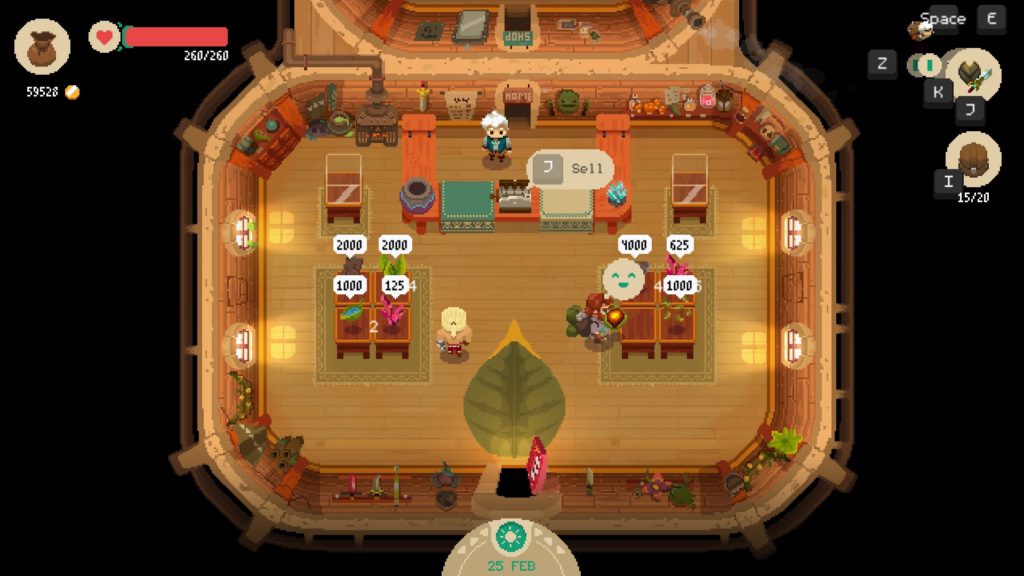
Another Happy Customer
In the small periods where you aren’t shopkeeping or looking for loot in dungeons, time can be spent breathing life back into the village of Rynoka. Upgrades for both the town and the Moonlighter can be purchased for gold at the town bulletin board. Upgrades for the town come in the form of staff, who once purchased, set up their own stores in Rynoka. Shops that can be purchased include an armory that allows you to buy armor and weapons in exchange for gold and materials, as well a potion shop that allows for health potions and stat upgrades for armor and weapons to be purchased. You can even buy another retailer similar to the Moonlighter that also sells loot found in the dungeons, meaning that if you’re too lazy to journey out to find a specific material required to craft a better sword, you can simply purchase it from the store. Be wary though, it’ll cost you a pretty penny. These upgrades are essential to building up your character, and they also aid in helping Rynoka appear like a living and breathing town.
You can also spend your hard earned merchant money on upgrades for the Moonlighter. There are small store upgrades such as purchasing a better chest to expand the stores inventory space, or buying a better cash register which leads to customer tips, but there are also more extreme upgrades, such as levelling up the entire store. Levelling up the Moonlighter costs a considerable amount of money as to be expected, but they are worthwhile investments if you want to be making money at a faster rate. Upgrading the store leads to the expected increase of inventory space and tables to place items, but it also leads to new mechanics being implemented altogether. The first expansion allows for the Moonlighter to be decorated with special items that buff the store, such as 10% longer open times, as well as the ability for the moonlighter to receive customer commissions. In regard to the commissions, customers make a request instore for a certain resource, offering you a hefty chunk of cash, so long as you meet their demands within a set amount of in-game days. Upgrades are essential to progression in Moonlighter, and thankfully they feel particularly rewarding.
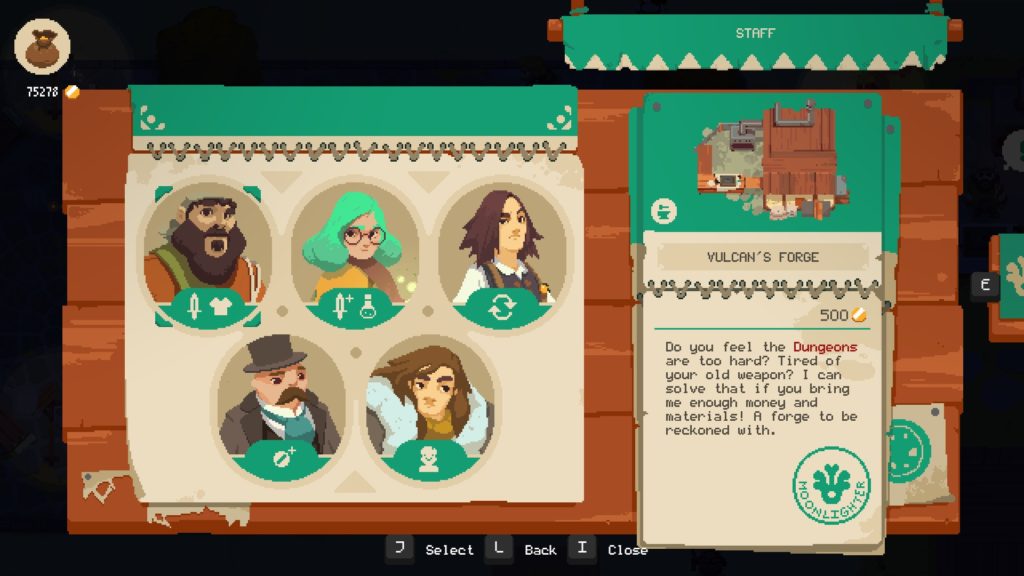
Upgrades for the town and the Moonlighter can be purchased at the bulletin board
I’m not sure if it was just a coincidence or not, but my first upgrade also introduced me to thieves, who attempt to pose as would-be customers, before deviously running off with whatever item they get their grubby mitts upon. This initially took me by surprise, as I saw a suspect looking individual run off with some crystals that were netting me a pretty decent sum of gold. Once thieves are in play, managing the store becomes a tad bit more stressful, especially considering the amount of money the items begin to sell for as you reach the later dungeons. Overall, the upgrades in Moonlighter feel extremely rewarding and exciting, as they don’t just net you inventory upgrades, but new gameplay mechanics also.
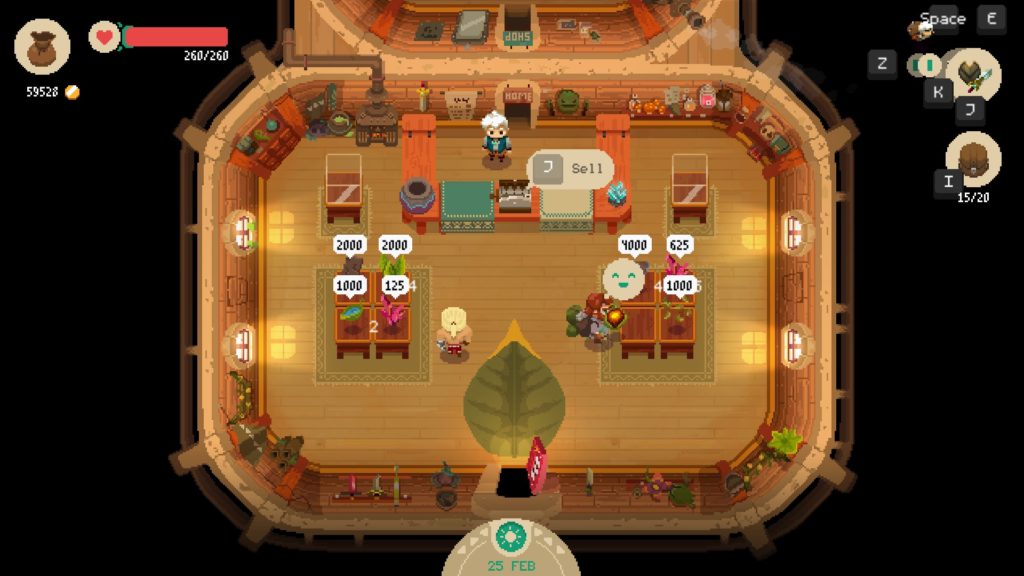
Thieves are always trying to nab your most lucrative products
Despite the sheer amount of positives that Moonlighter brings to the table, it does have a few minor issues. One of my biggest faults with the game is the hitboxes of the enemies present in the dungeons. As I progressed through the game, my main weapon setup was the sword and shield combo, however, despite clearly slicing away at an enemy, my hits didn’t seem to register. Most of the time this wasn’t an issue but on a few occasions I went in for the killing blow, only to be rejected and dealt a heavy blow of damage instead. I also wish there was more of a narrative present throughout Moonlighter. I was as enthralled as Will was to see what lay behind the 5th door of the dungeons, but I did find myself wishing there was more of a narrative reason for rebuilding the town of Rynoka and the Moonlighter, although I’m probably being a tad nitpicky.
At the end of the day though, Moonlighter is a truly brilliant title that I find myself extremely addicted to and enamored by. The constant trade off between delving deeper into dungeons or cutting your losses with the loot you have is a consistently intense and thrilling experience, and even when you get too greedy and die in the dungeons, the loss of all your loot only seems to inspire another journey. Despite the seemingly overwhelming depth in each of the games core mechanics, the game almost never feels overbearing and difficult to comprehend. The fact that Moonlighter can both feel mechanically deep and simplistic at the same is a testament to the games design. Pair the addictive gameplay loop of collecting and selling loot, with a brilliant pixel art style and an alluring soundtrack, and you’re left with one of the most satisfying games of recent memory. Moonlighter is available now on PlayStation 4, Xbox One and PC, with a Nintendo Switch version slated for release in the near future.
Huge thanks to 11 bit studios for a Steam code of Moonlighter.
May 6, 2018News
If you’re a fan of 2D platformers, you’ve more than likely heard of the Shantae series. If you haven’t than you’ve been missing out. Shantae: Half-Genie Hero Ultimate Edition is an expertly crafted 2D platformer developed by WayForward, a studio that is renowned for their expertise in designing platforming titles. Much like the previous Shantae titles, Half-Genie Hero is a brilliant experience, one that manages to tell an enjoyable story with its loveable cast of characters, while also offering satisfyingly smooth gameplay.
The story begins as Shantae, the belly dancing daughter of the genies is awoken by a mysterious spirit that warns her of an impending attack on the human and genie worlds, before she is quickly awoken to realise it was merely just a dream. After this dream foreshadowing the possibility that not all is quite right in Sequin Land, Shantae is tasked by her uncle to help him build his latest invention called the Dynamo, a device to that will ward off pirates and keep Scuttle Town safe. The blueprints to the invention are stolen by Shantae’s rival Risky Boots, sending her on a journey to recover the blueprints and the parts required to build the device, while also stopping the dastardly schemes of Risky.
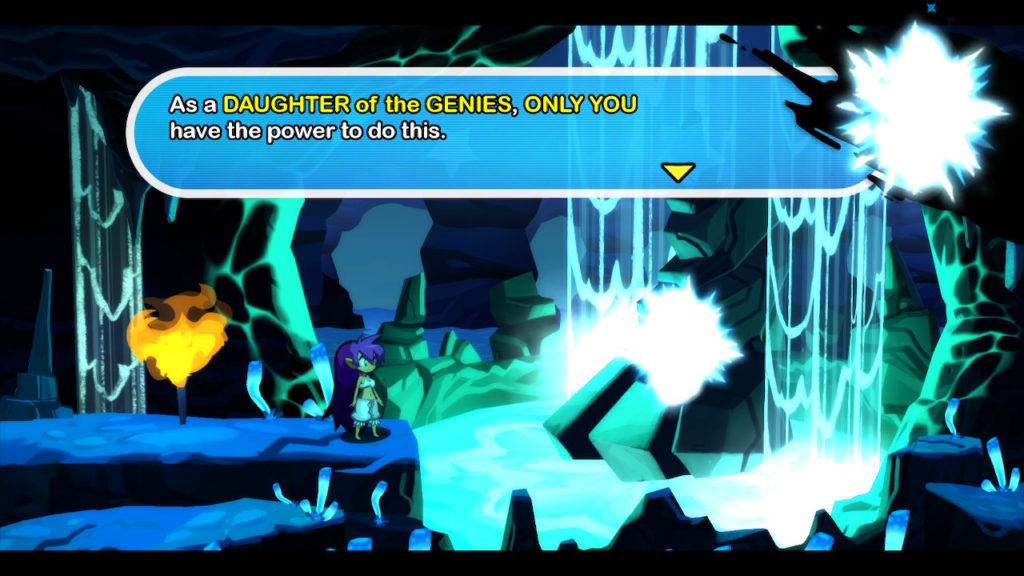
A mysterious spirit sends Shantae on a quest to save the world
The narrative merely serves to provide a reason for exploring the locales throughout the world, but despite that, I found the story rather engaging, in part due to the brilliantly written character dialogue, as well as the substories told in each level. For example, one level sees Shantae busting a corrupt Baron trying to sell human girls with fake tails as mermaids because he can’t keep up with the demand of the mermaid selling business. The writing is hilarious throughout the entire game, with characters making silly quips and jokes that actually had me laughing out loud. The cast of characters all feel well written, which in turn led to myself growing a fondness for them, Shantae and Rottytops especially. The story isn’t overly complicated, but the simplistic and entertaining narrative serves perfectly to compliment the game’s strongest asset, its gameplay.
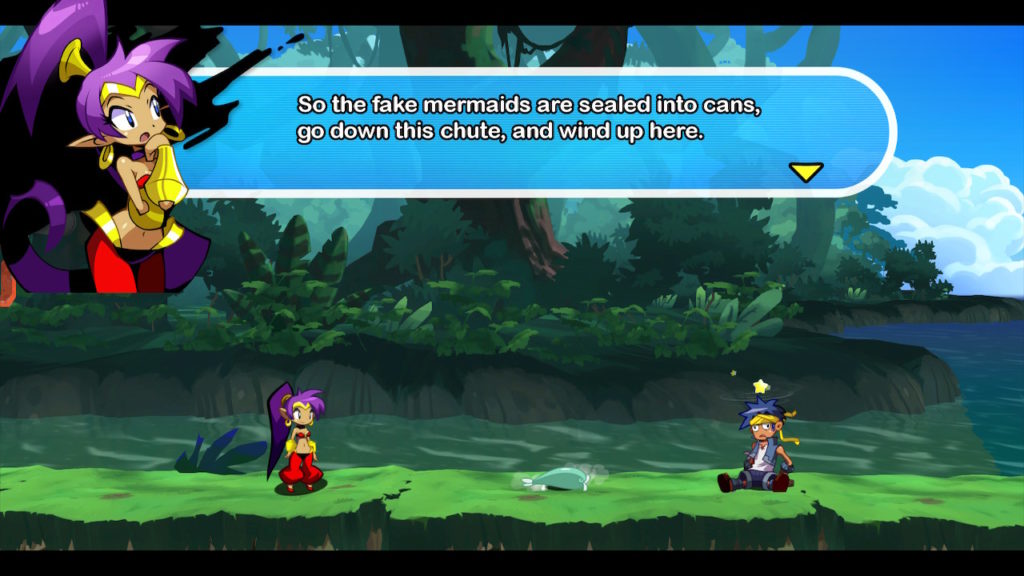
Adorably silly storylines feel right at home in Half-Genie Hero
In terms of gameplay, Shantae is undoubtedly one of the smoothest and satisfying 2D platformers I’ve ever played. At its core, Half-Genie Heroes gameplay is a classic 2D action platformer, with slight metroidvania elements. Each level has Shantae traversing a linear level, using her hair to attack enemies, and her belly dancing to transform in to animals required to progress through the level. There’s a monkey who can climb walls, an elephant that can break open new pathways that were previously not accessible, and many other creatures that you’ll unlock as you progress further in the approximately 7-8 hour campaign. Boss Battles also feature at the end of each level, and this is where the combat of Half-Genie Hero shines. Despite the simplicity of incessantly whacking your foe with Shantae’s hair, it feels extremely satisfying.
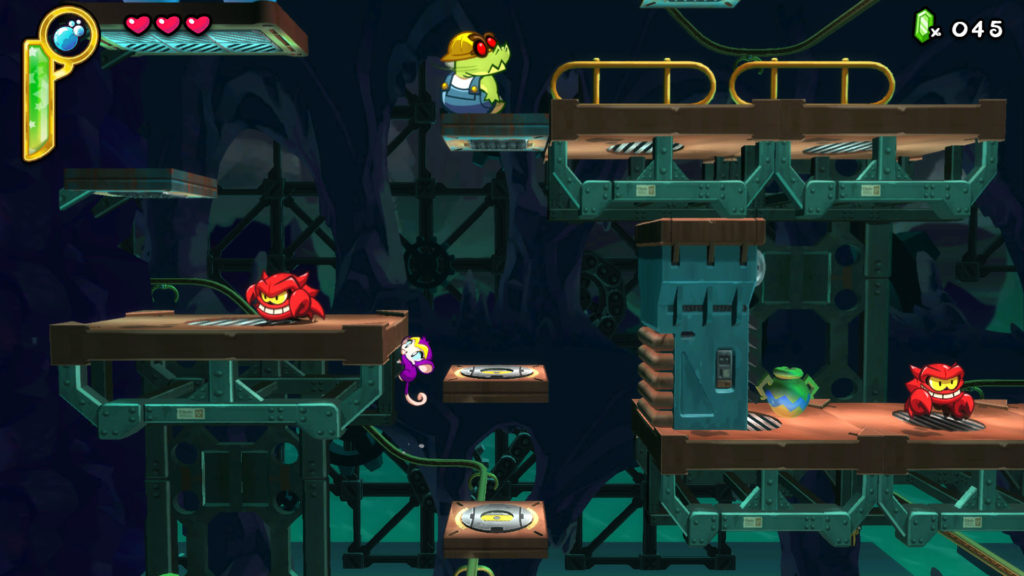
A Monkey is just one of Shantae’s numerous transformation options
You will find yourself using the aforementioned transformations regularly and they are plenty of fun to use, although most of the time they are simply used to backtrack to previous levels and collect items needed to progress the story. I wasn’t against the idea of backtracking in Half-Genie Hero, but the lack of a map within levels meant that some time was spent hopelessly looking around for the intended area I was meant to discover with my new found abilities, which was often a little frustrating. If you’re ever lost however, you can speak to the lady in the Bath House in Scuttle Town, as her hints despite not directly telling you where to go, can be particularly helpful. The item shop in Scuttle Town allows for you to cash in your gems for items such as Shampoo to upgrade Shantae’s hair, to items such as fireballs and scimitars, that serve as a secondary weapon option to Shantae’s hair. At the end of the day, Shantae’s gameplay is well refined and pleasure to experience, and despite feeling that the main game is a little too easy and not quite long enough, I had a great time from start to finish.
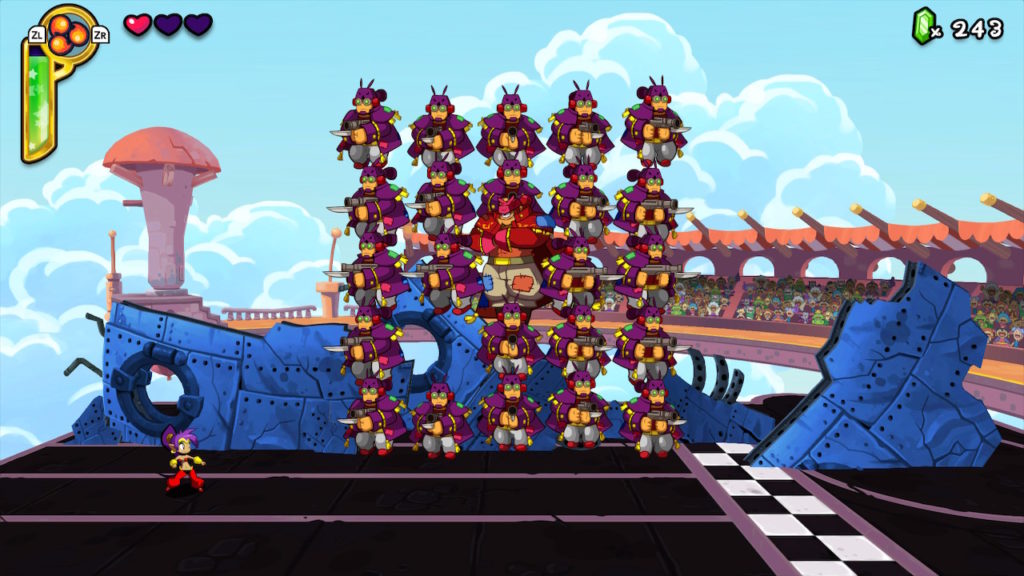
The gameplay of Shantae: Half-Genie Hero is top notch
When the main story comes to a close, there is still a surprising amount of content left to be explored. The Ultimate Edition is comprised of the Half-Genie Hero base game, as well as all of its subsequent DLC releases, meaning that you’ll have an abundance of additional modes to play through. There’s a Hero Mode that allows you to play through the main story with all the transformations already unlocked, as well as a hardcore mode that makes things a little bit more difficult than the original mode. I don’t particularly see the point in Hero Mode, but I did spend some time in Hardcore Mode, and despite it still not being as difficult as I would like, I still loved my time with it.
Friends To The End serves as a new mini campaign set during a particular moment in the main game’s story. Players assume control of Shantae’s pals Sky, Bolo and Rottytops, as they attempt to save her from giving in to evil. You make your way through each level alternating characters, who each have a distinct ability. Sky for example can build platforms and glide, while Rottytops can get through barriers by throwing her head through them (she’s a Zombie girl, it makes sense ok). The mode feels entirely different to the main mode, but it still manages to feel engaging and fun throughout it’s 3 hour runtime. The same can be said for the Pirate Queen’s Quest mode, which lets you play the game’s storyline from the perspective of the antagonist, Risky Boots.
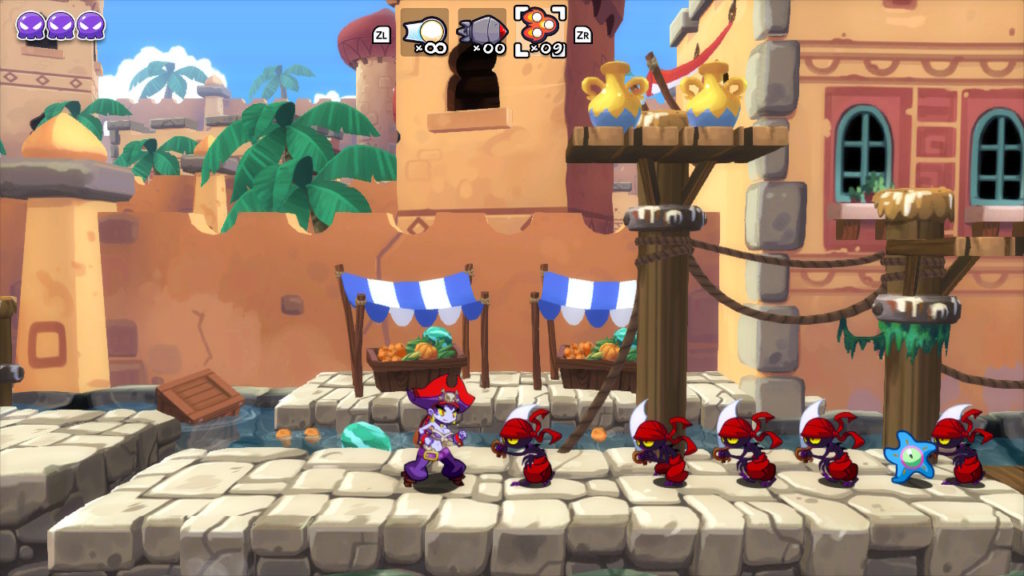
Playing as Risky Boots is a heap of fun
Costume mode offers three campaigns based solely around the costume that Shantae is wearing. The Ninja mode sees Shantae donning a Ninja outfit, which allows her to run and teleport like a Ninja, with a Katana and Shuriken being her weapons of choice. Beach mode sees Shantae attacking enemies with beach balls in her swimwear, while collecting sunscreen to ensure she doesn’t get sunburnt. It’s bizarre yet somehow it makes for an extremely frantic mode, where you are always desperate to find the next bottle of sunscreen, because without it, Shantae begins to lose health exceedingly fast (don’t forget the sunscreen kids!).
Lastly in the costume mode campaigns we have Officer mode, which sees Shantae assume the role as a Police Officer tasked with collecting the numerous space hooligans scattered around each level. Shantae’s weapon in this mode is a blaster that fires pellets, leading to gameplay that feels similar to that of Mega Man. The levels require more puzzle solving than other levels, leading to a slower pace, but the mode is still extremely delightful. The experiences offered by each mode are unique and enjoyable, and despite reusing the same levels played in the main story, the mechanics that each mode provides leads to campaigns that feel like entirely different games. If you want to invest more time in Half-Genie Hero after the main mode, I highly recommend these campaigns.
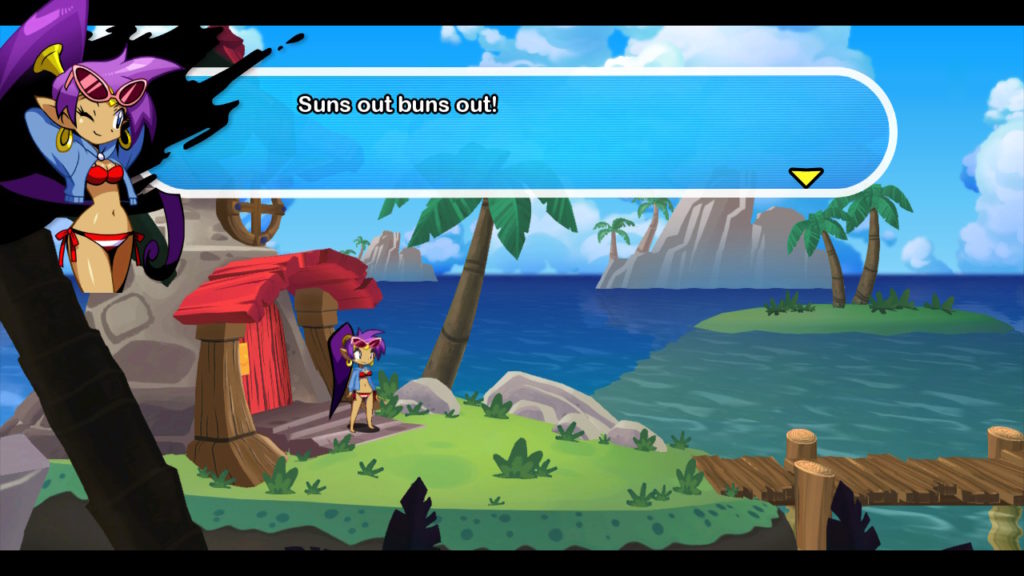
Beach mode reminds us all of the importance of wearing sunscreen
Overall, Shantae: Half-Genie Hero Ultimate Edition is a great experience that has left me completely enamored. With charming characters, astounding gameplay, a toe-tapping soundtrack and a bevy of content, it’s hard not to sing the praises of Shantae. Regardless of whether you’re a veteran of platformers or a beginner, you’re sure to derive plenty of enjoyment from Shantae: Half-Genie Hero Ultimate Edition.
Big thanks to WayForward Games for providing the Nintendo Switch Shantae: Half-Genie Hero Ultimate Edition review code.
Apr 24, 2018Animal Crossing
Another Day, Another potential Animal Crossing Switch tease. Nintendo has recently released a new update to Animal Crossing Pocket Camp. One of the main new features was the ability to buy fortune cookies, which are essentially Pocket Camp’s version of loot boxes. For those who aren’t familiar with fortune cookies, they are traditional Chinese sugary cookies, usually packed with a note that is supposed to bring good fortune. Despite being somewhat overpriced, these fortune cookies contain some awesome items.
On April 26th, Nintendo will release new fortune cookies, including some exciting new items to collect. One of the new fortune cookies, known Hopkins’s game cookie, contains a bunch of Nintendo console items, such as the Nintendo Gamecube, the Nintendo 3DS, and awesomely enough, the Nintendo Switch. The cookie will cost Pocket Camp players a whopping 80 Leaf Tickets. What is particularly interesting is the prominence of the Nintendo Switch over all the other items in the cookie. The cookie is black in the middle with red and blue either side, resembling the neon Nintendo Switch console, and Hopkin can be seen in the image excitedly holding onto his Nintendo Switch.
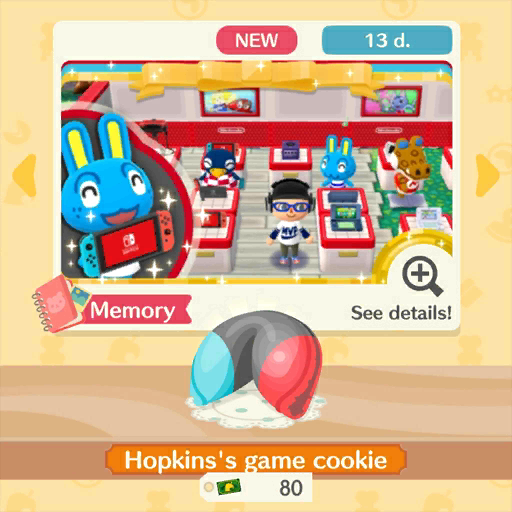
The prominence of the Nintendo Switch in the imagery for Hopkins’s game cookie is by no means an indication of an imminent release of Animal Crossing Switch information, but it does seem like Nintendo’s incessant teasing is leading toward a major announcement. With E3 a mere 6 weeks away, Nintendo may just be cleverly teasing AC fans until then, however the acknowledgment of Animal Crossing Switch could possibly arrive far sooner, with Nintendo’s fiscal year earnings release scheduled for April 26th. In these investor meetings, Nintendo often discusses upcoming titles that will be crucial to their earnings for the following year, meaning that some game announcements could possibly be made before or during the investor meeting. Animal Crossing New Leaf was announced in a similar fashion, so it is possible that Animal Crossing Switch could be confirmed by this investor call.
There are two things that are for sure right now, Animal Crossing Switch rumors are becoming more and more prominent. It’s safe to say an Animal Crossing Switch game will be announced sooner than later. You can get up to date on the latest bunch of Animal Crossing Switch rumors and hints in the Rumor Roundup below.
Recent Animal Crossing Switch Rumor Roundup
- Nintendo recently did something similar in Splatoon 2, when they teased bugs from Animal Crossing in a (then) newly released stage. In case you missed that, check out the images here.
- Just a few days ago Nintendo made some changes to the official Animal Crossing website, with news and video section being added, and then quickly removed ones fans became aware of it. You can check out the website changes here.
Apr 20, 2018News
In January 2018, Nintendo revealed Nintendo Labo, a unique product for Nintendo Switch. Labo involves making creations out of cardboard, and utilizing them alongside the Switch and its peripherals, to create a unique gameplay experience. Whether you know plenty about Nintendo Labo, or nothing at all, here is a list of things that everyone should know about the new Nintendo product.
What is Nintendo Labo?
Nintendo Labo is a rather hard thing to explain, but I’ll try my best here. Nintendo Labo is a set of buildable cardboard accessories that allow for unique gameplay experiences on the Nintendo Switch. Nintendo Labo allows for the design of numerous types of cardboard creations, such as a Fishing Rod, an RC car and a Piano. The cardboard designs serve as a way to play a variety of different games on the Nintendo Switch hardware, even going as far as to hold the console itself, something that can be easily seen in numerous Toy-Con designs.
Yes, I did say Toy-Con, which is what each Labo design is creatively called, considering they all utilise the Joy-Con and their features. The RC car for example, makes use of HD rumble of the Joy-Con, allowing for a design that doesn’t have wheels to somehow drive.
The Labo is an extremely unique and interesting idea, that despite being intended mainly for children, will surely garner a following with people of all ages.
What is in each Nintendo Labo Kit?
The Nintendo Labo released with two Toy-Con kits, a Variety Kit and a Robot Kit. The Variety Kit lives up to its name, offering a variety of different projects to build.
The Variety Kit contains the cardboard to make the following:
Two Toy-Con RC Cars
Toy-Con Fishing Rod
Toy-Con House
Toy-Con Motorbike
Toy-Con PianoThe Variety Kit provides plenty of Toy-Con to play with, but the Nintendo Switch Labo software is where these designs will truly shine. The Robot Kit may only provide the Robot Toy-Con, but it provides the most advanced Labo experience, being a wearable Toy-Con that has physical involvement from head to toe.
The Robot Kit contains the cardboard to make the following:
Toy-Con Robot
Visor
Main Body
Robot Shoes
Robot ArmsThe Robot Kit seems to be the most fleshed out Toy-Con, and hopefully the Nintendo Switch Labo Software manages to show off the true extent of its capabilities. There is also a Nintendo Labo Customization set releasing alongside the Toy-Con Kits. The Customization Kit allows Labo players to further customize their Toy-Con creations, allowing for more personality in Toy-Con designs.
The Customization Set contains the following:
Two Stencils
Two Sticker Sheets
Two Tape RollsWhat do the Toy-Con provide Gameplay-wise?
The variety kit, consisting of five different Toy-Con creations, provides numerous gameplay experiences.
The RC Cars can be used to simply drive around, but if you’re feeling daring, can easily be used to race and battle against each other.
The Fishing Rod offers a fishing game that sees you going from catching only small fish, to scouring the depths of the seas to find larger marine life, such as sharks. You can even visit your caught fish in the aquarium, and design fish of your own!
The Toy-Con House sees you befriending a cute, imp-like creature, using several different things to interact with it, and its home. The cardboard blocks provided with the House can be plugged in to provide various minigames and other interesting ways to interact with your new fluffy friend.
The Motorbike allows for a racing game that looks to heavily resemble Mario Kart. Players can race in Grand Prix mode, as well as create their own unique racing tracks.
The last Toy-Con in the Variety Kit is the Piano, which seems to have a decent amount of depth to it. You can plug in different pieces to change the piano tones to cat noises or other silly sounds, while another mode allows the piano keys to use the vibration of the Joy-Con, offering different ways to make music.
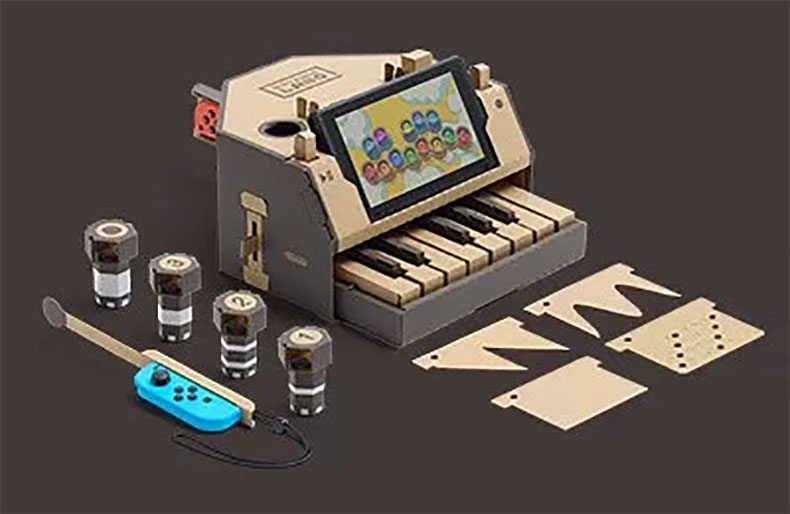
The Variety Kit offers plenty to do, and is sure to keep you entertained for a decent while.
The Robot Kit despite coming with only the Robot Toy-Con, seemingly still has plenty to offer. As an enormous Robot, you can walk around and punch and kick within the environment, destroying all in your path to get as high a score as possible. Holding your arms at your side allows for your Robot to fly, crouching will turn you into a tank, and putting on your trusty visor will allow you to experience a first-person mode.
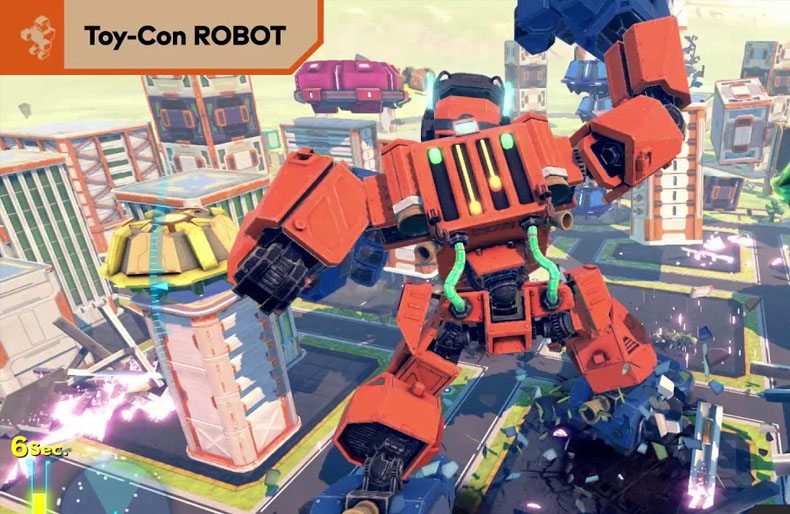 There’s plenty more to be experienced with the Toy-Con Robot, but I won’t spoil it here.
There’s plenty more to be experienced with the Toy-Con Robot, but I won’t spoil it here.How much does each Nintendo Labo Kit cost?
The Nintendo Labo Variety Kit launched with a recommended retail price of $69.99 in North America, £59.99 in the UK, and $99.95 in Australia. The Nintendo Labo Robot Kit is somewhat more expensive, retailing at $79.99 in North America, £69.99 in the UK, and $119.95 in Australia. Now, this may seem far too overpriced for pieces of cardboard, but it’s important to remember that each Nintendo Labo Toy-Con Kit comes with a game.
The Nintendo Labo Customization Set, which comes with stickers and other craft materials to spruce up you Toy-Con designs, retails at $9.99 in North America, £8.99 in the UK, and $14.95 in Australia.
Where can I get Nintendo Labo ?
You can now but the Nintendo Labo Variety Kit here, the Robot Kit here, and the customization pack here.
What are your thoughts on Nintendo Labo?
I know that I’ll be getting Nintendo Labo the moment it releases, but what about you guys and gals? Are you looking forward to Labo? Make sure to let us know!
For more exciting upcoming games, check out the latest game from Chucklefish, Stardew Valley’s publisher right here. The original Harvest Moon creator is also releasing a new game this summer, take a first look!Apr 13, 2018News
In the world of Penny Punching Princess, money is everything. In the past, physical power meant everything, but as the time’s changed, so did the people. Capitalism took hold of the world and money quickly became the answer to everything. This premise sounds particularly dark and dismal, yet somehow Penny Punching Princess manages to be a cute and colorful beat em’ up/role-playing game hybrid, that pairs an odd yet charming story, with amazingly addictive gameplay.
The story of Penny Punching Princess centres on the titular money-hungry Princess and her stag beetle butler Sebastian, as they journey to avenge her father by taking down the Dragaloan family, a devious bunch who tricked her father into investing all his money into their mutual funds and foreign exchange, which lead to debt and his death. If you think that sounds absolutely bizarre, you wouldn’t be wrong. The narrative on display isn’t afraid to be outlandish, which leads to a story that is rather silly and enjoyable. The story is aided by its brilliantly executed translation, which was done by NIS America, with the dialogue exchanged between characters being hilariously written. The character interaction in the story is told between levels through simple text box cutscenes, accompanied with the characters and their bobbing heads. Although the simplistic cutscenes are quite cute and not inherently bad, I wish there was more effort put into them, such as voice acting for all dialogue, or more impressive cinematics. It’s a minor gripe nonetheless, as I still enjoyed what the silly story had to offer.
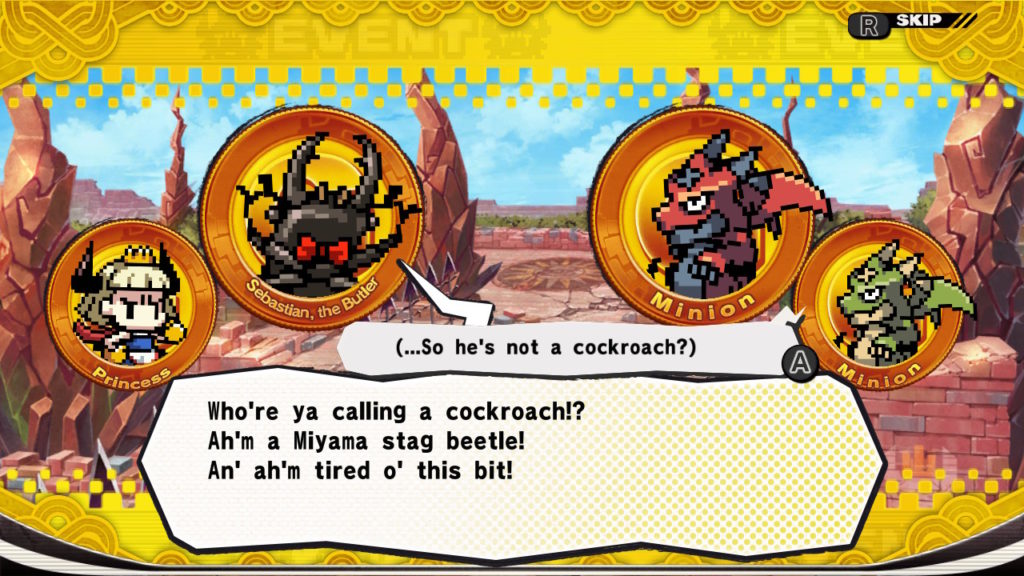
The writing on display is both charming and entertaining
The gameplay in Penny Punching Princess is undoubtedly the strongest component of the game. Each level has you tasked with taking out hordes of enemies in order to reach the end of the level. How you deal with the enemies however, is up to you. You have the physical attacks of the princess, such as a light punch or a heavier punch that can be charged in order to do more damage, as well as the greatest weapon of all, a magical calculator.
As previously mentioned, money means everything to those in the Capitalist world of Penny Punching Princess, so much so, that the enemies hell-bent on taking you down can simply be bribed into helping you. Money is power, after all. Bribing obviously requires money, so you won’t always have the ability to do so, meaning you must plan efficiently when to spend your money, and how much is wise to spend.
Enemies aren’t the only thing that can be bought by money. The Environment around you can be purchased to aid you also, such as fire breathing statues and spike traps. You can even pay off doors that allow access to loot you otherwise wouldn’t have been able to obtain. The fact that almost everything can be paid off except the end of world bosses is awesome, as it allows for variety in how you approach each level. If you’re keen to try your luck you can bet a cash amount of your choosing and try the coin miracle option, which could possibly reward you with some health or more money. There is a surprising amount of depth to the calculator mechanic, and despite it being rather simplistic in its execution, it’s an extremely unique and fresh idea that I enjoyed tinkering with.
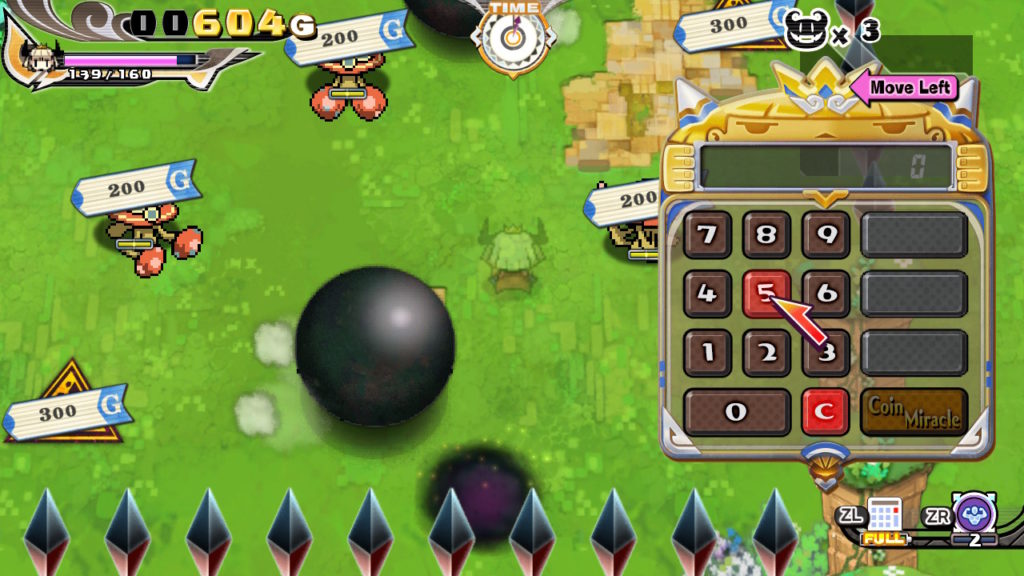
The freedom to bribe whatever you like allows for multiple approaches to each level
The Princess can also obtain upgrades by acquiring Zenigami statues from the golden chests in each level, which act as the games skill points currency. The skill points awarded for the collection of each statue allow for upgrades such as new attacks for the princess, more money dropping from enemies, as well as the expected health and attack upgrades. Despite not requiring much effort to find, locating Zenigami statues in each dungeon feels remarkably rewardable and satisfying. Zenigami statues can also be crafted, as well as armor, that come with certain buffs and effects. In order to craft said items, you must collect a certain amount of particular types of enemies, which means there is some grinding required at times. The grinding in order to craft statues or armor never feels too egregious, but it can often hinder the flow of the game.

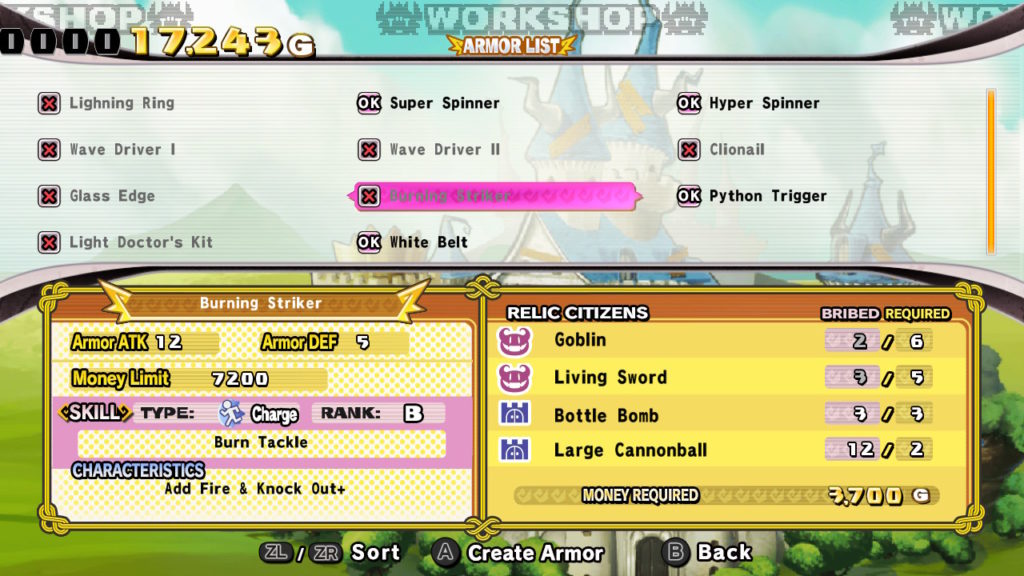
Bribing certain enemies and environments unlock armor upgrades for you to purchase
Despite the calculator being the most unique and exciting mechanic in the game, it does have a couple of shortcomings regarding its use. The calculator most of the time isn’t too difficult to use, but when in fights against plenty of enemies, it can be rather finicky trying to input the right cash amount and pick the ideal target to bribe. As you get more proficient with the controls, it becomes easier to juggle both dodging enemies and using your calculator, but it can be frustrating at times, especially when you overpay an enemy that you weren’t trying to bribe in the first place.
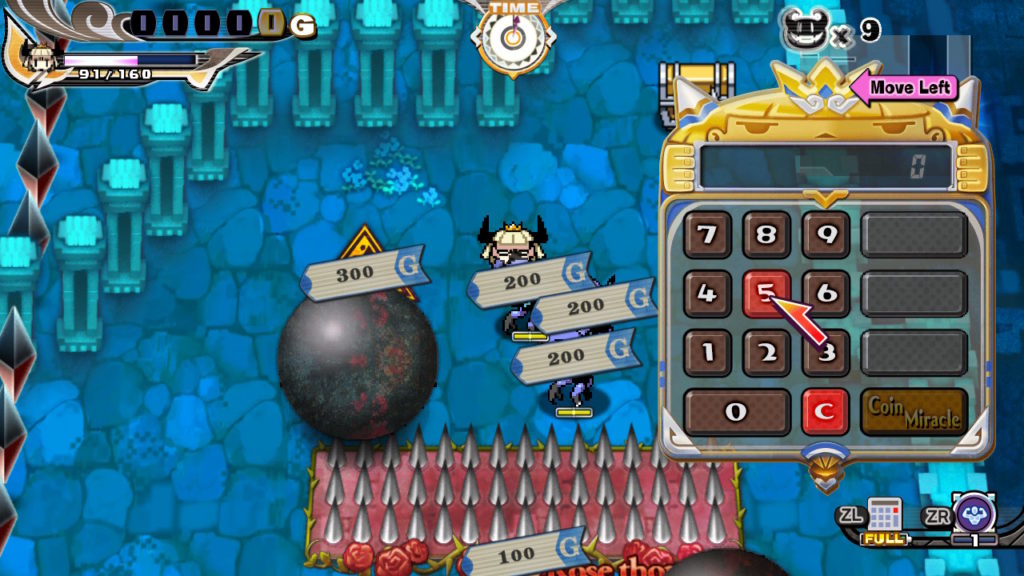
Using the calculator effectively in busy fights proves difficult
The biggest issue I had with the game however was the difficulty spikes. The difficulty often ebbs and flows, meaning that some levels will be an absolutely cakewalk, while others will be so difficult that you’ll be left to churn through already beaten levels numerous times in order to gather the resources to better upgrade your character. The difficulty of the game at times can often feel rather unfair, which is further compounded by the sparse checkpoints throughout each level. It’s never fun having to beat an area you’d already beaten 5-10 mins before dying again and again. These issues ultimately disrupt the games flow, which is definitely an annoyance, but if you can make it through some annoying moments there is plenty of fun to be had.
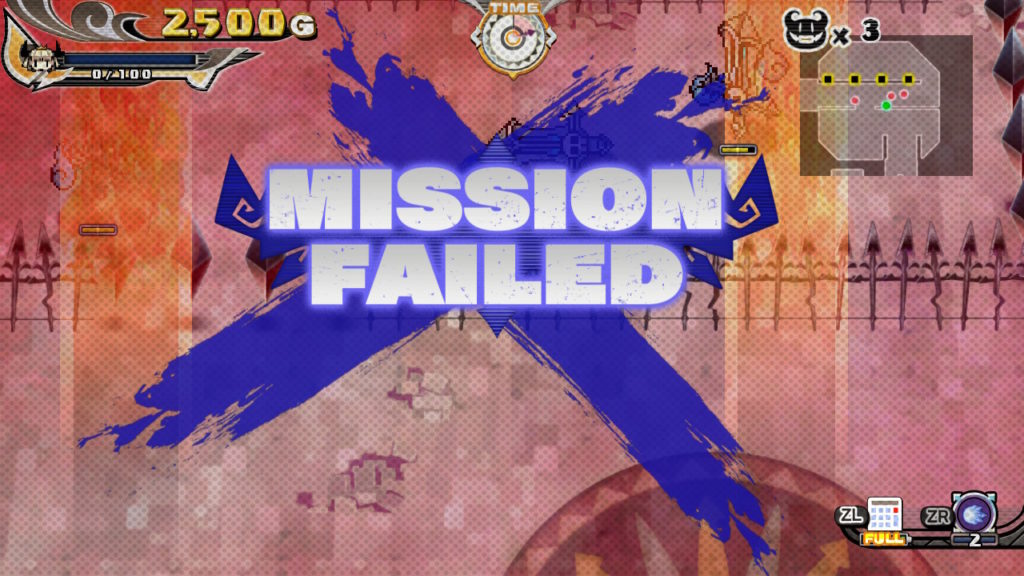
You will see this death screen plenty of times
Penny Punching Princess provides an extremely addictive experience. The narrative is ridiculous yet somehow rather amusing, the same of which can be said about the cast of characters, who all exhibit humorous writing that keeps the task of reading dialogue entertaining rather than monotonous. The gameplay of traversing dungeons, collecting coins, finding chests, and killing/bribing the multitude of enemies along the way is an extremely satisfying gameplay loop that remains enjoyable throughout the variety of chapters, albeit being derailed occasionally by the unpredictable difficulty spikes. Pair the aforementioned elements with a brilliant soundtrack and beautifully colourful visuals, and you’ve got yourself an awesome beat ‘em up RPG that is destined to keep you entertained for hours. Despite having some minor issues in regard to difficulty spikes and grinding, Penny Punching Princess is a thoroughly delightful experience that I implore everyone to try.
Big thanks to NIS America for providing the review copy of Penny Punching Princess on Nintendo Switch.
Mar 21, 2018News
Upon first glance of Celeste, it’d be easy to determine that it’s a retro-inspired, overly difficult 2D platformer similar to games such as Super Meat Boy, VVVVV, and 1001 Spikes. While Celeste does indeed nest itself alongside the aforementioned titles, it manages to place itself on a pedestal above games of a similar ilk, successfully managing to pair brilliantly designed platforming gameplay, with a story that focuses on a particularly serious subject matter.
Despite being part of a genre that doesn’t favor having much of a narrative presence, Celeste offers an interesting story, centering on the main character Madeline and the internal battle she has with her emotions. Madeline has set herself a personal goal, to climb Celeste Mountain. She’s a sweet, quirky and caring young woman who is lost within herself, clearly struggling with the mental demons that accompany anxiety and depression. Her fears and insecurities appear before her in the form of her reflection, a physical manifestation of her personal demons. This alternate version of Madeline represents her negative side, a side of her that she must learn to overcome.
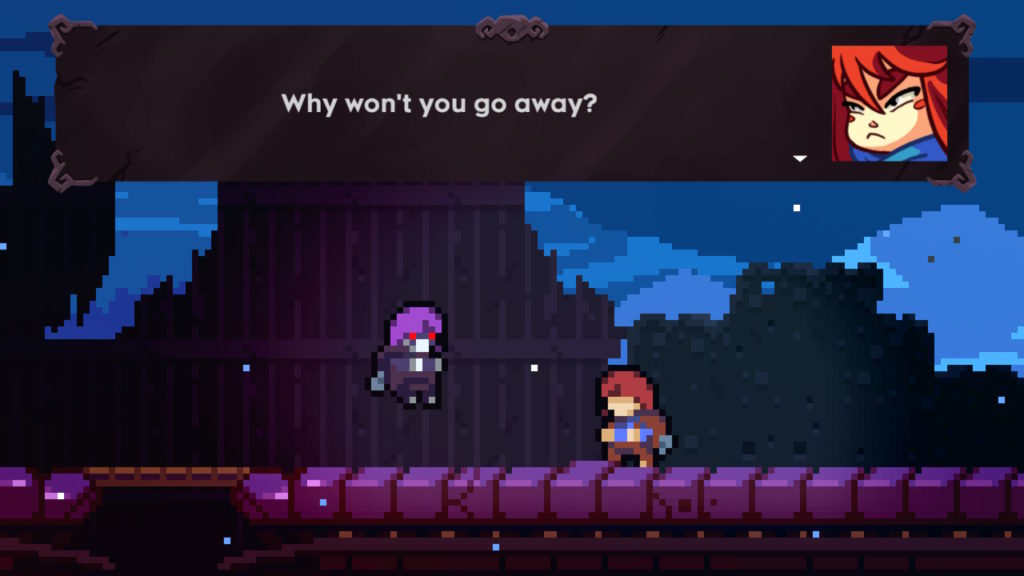
While journeying up the titular mountain, and fighting against her negative self, Madeline meets some interesting characters. Mr Oshiro is an insecure ghost who runs the abandoned hotel on Celeste Mountain, while Theo is another climber, who is a charismatic photographer trying to garner a following on the social media platform InstaPix (cute nod to Instagram). Each character in Celeste has interesting and charming dialogue, making the exchanges with characters enjoyable. If narratives aren’t what you’re after, dialogue and cutscenes can be skipped, but I implore you to listen to the story that Celeste wants to tell.
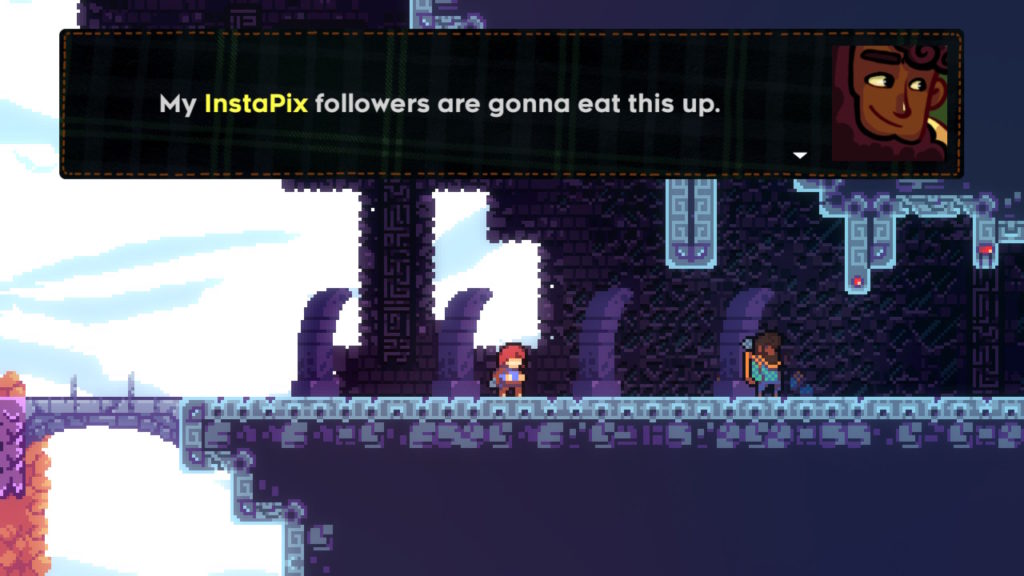
Celeste’s story is about overcoming obstacles and hardships in life, and that at the end of the day, if you believe in yourself, you’re more than capable of succeeding. The message of the story can be also be attributed to Celeste’s gameplay, as learning from your failures in each level is the key to progression.
Speaking of gameplay, Celeste’s is near perfect, offering up a challenge while also being fair to the player. The game can initially feel unfair, and deaths will undoubtedly hurt and frustrate, but they are almost always at the fault of the player, which is a testament to the game’s rock solid design. What aids Celeste’s brilliant gameplay is the fluidity of its movement, as traversing through the variety of environments on your journey to the peak of Celeste Mountain feels brilliant. The smoothness and ease of movement that the games mechanics provide allows the game to explore multiple different types of puzzle designs, with nothing feeling overly impossible to achieve with the tools you are given. Madeline can jump, dash and climb throughout her ascend of Celeste Mountain, with each mechanic having a limitation (must touch the ground to recharge dash ability etc). The mechanics and levels pair perfectly, maintaining a fair challenge throughout the entire journey. If things get tough, there’s an assist mode, that allows for tweaking of game speed, amount of air dashing etc. Celeste’s gameplay is remarkably refined as is, while still offering those who may struggle a way to cater the experience to their liking.
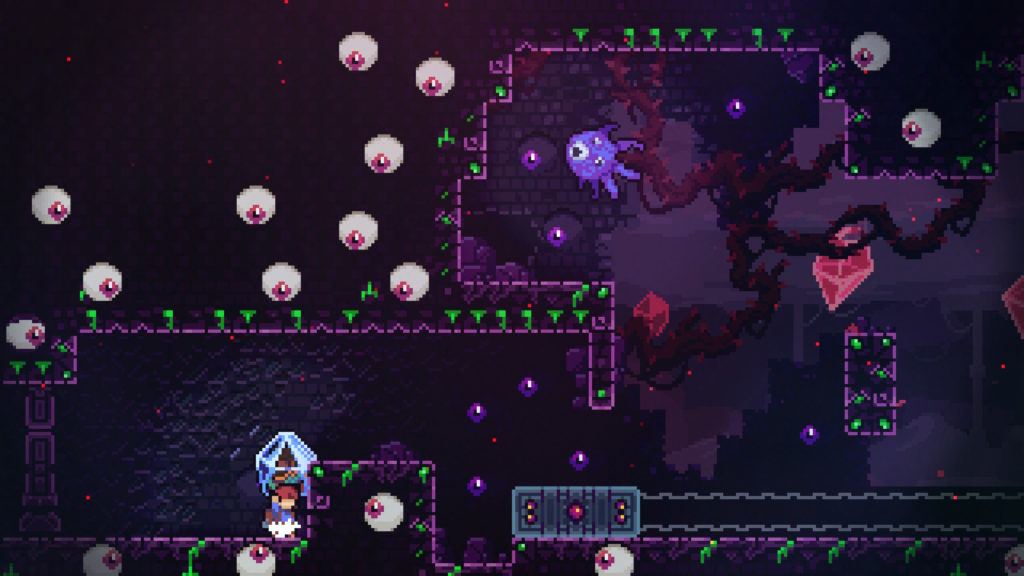
Each level in Celeste has its own distinct look and feel, from the to be expected snowy mountains, to a decrepit hotel and a long lost city. Each level also brings a new mechanic to the table, ensuring that there is always something fresh and new to encounter in each subsequent level. For example, one level has red tendrils sprouting from its floors and walls, that if touched, spout out a red tumor that will kill you if you have to touch it again. This mechanic eliminates the ability to backtrack, meaning you have to make the most of every step in order to progress. The variety in each level sets them apart, showing off Celeste’s sheer amount of creativity in its level design. The game’s levels each have distinct tasks required to progress, such as locating a key to unlock a door, but for those keen to stray off the beaten path, there are plenty of additional goodies to find.
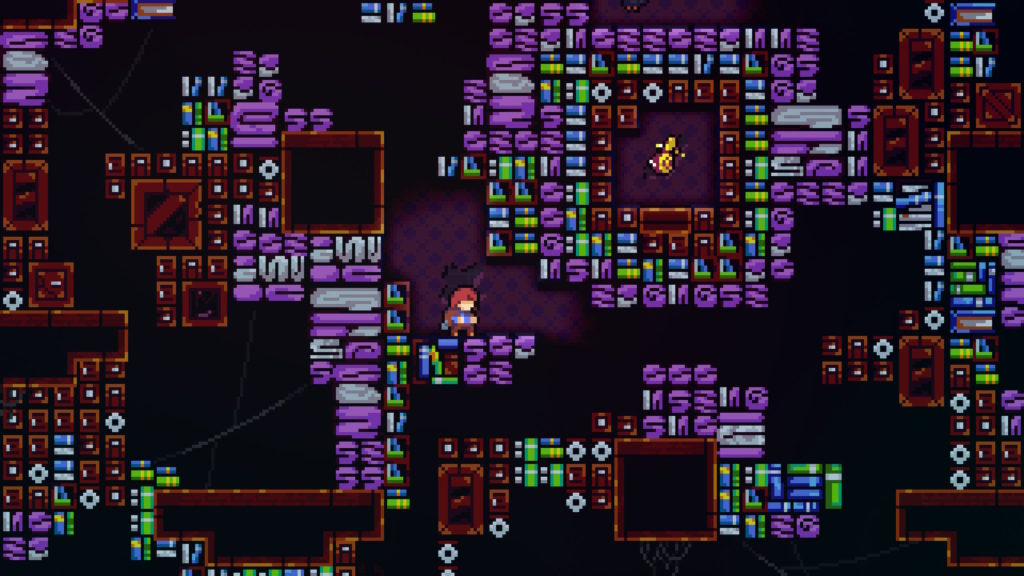
Strawberries serve as Celeste’s main form of collectible, providing a reward for completing optional rooms or finding hidden pathways. Strawberries provide no real reward at all, they simply serve as something to collect as a badge of honour, and despite not having a huge pay off for their collection, they had me hooked in my attempt to collect them all, which is a testament to how fun the challenges around them are. Strawberries aren’t the only special items you’ll find during your time with Celeste, as each level contains a particularly well hidden Cassette tape, which offer an alternate and far more difficult rendition of the level the tape was collected in. These alternate levels, known as B-Sides (cute cassette tape reference) provide Celeste’s true test, as they pose a far greater challenge than the already tough original levels. For example, in a single run of a B-Side level, I died 600 times, which was half the amount of deaths I accrued when playing through Celeste’s 7 main story chapters. The B-Sides are nice rewards for those keen to test their skills. Blue crystal hearts also appear in Celeste’s main chapters, with their collection allowing for access to a Chapter 8 after completing the main game. Overall, Celeste’s smooth gameplay and fun to obtain collectibles come together to provide a challenging but addictive gameplay experience that is hard to escape the grips of.

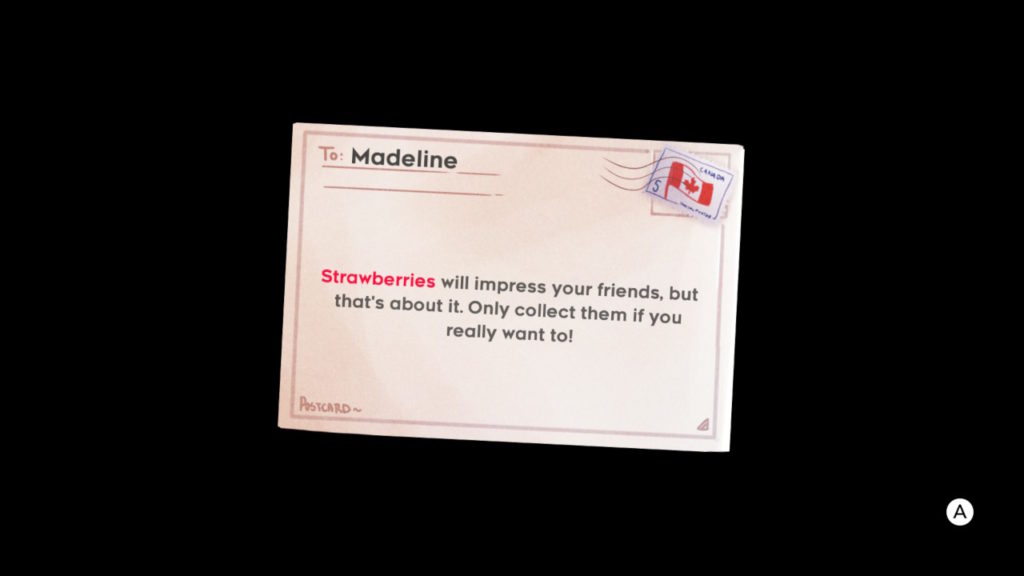
Celeste is arguably one of the greatest platformers ever created, masterfully pairing smooth and rewarding gameplay with a meaningful story with a strong message. The gameplay feels amazing to play and is always an enjoyable experience, the soundtrack aids the feeling of each level perfectly, and the narrative is both compelling and well executed, with a bunch of delightful characters featured throughout. Celeste is a lovable and addicting adventure, and a game I recommend that everyone experience at least once.
Celeste has been reviewed on the Nintendo Switch.
Mar 20, 2018News
Earlier today, Nintendo had their first Nindies Showcase for the year, showing off a slew of new unannounced titles. Here’s a definitive list of every game shown in the Nindies Spring Showcase:
- Mark of the Ninja Remastered – Fall 2018
- Fantasy Strike – Summer 2018
- Just Shapes & Beats – Summer 2018 (first on Nintendo Switch)
- Garage – Spring 2018 (first on Nintendo Switch)
- Pool Panic – Coming in 2018 (first on Nintendo Switch as System Exclusive)
- Bomb Chicken – Summer 2018 (first on Nintendo Switch)
- Lumines Remastered – Spring 2018
- Reigns – Kings & Queens – Spring 2018
- Light Fall – Spring 2018 (first on Nintendo Switch)
- West of Loathing – Spring 2018 (System Exclusive on Nintendo Switch )
- Pode – Spring 2018
- The Messenger – Summer 2018
- Bad North – Summer 2018 (first on Nintendo Switch)
- Banner Saga 3 – Summer 2018
- Banner Saga 1 & 2 – soon
The pick of the bunch for myself personally was Light Fall, a fast-paced 2D platformer that can be easily compared to Super Meat Boy. Fans of tactical role-playing games will also be happy, with the announcement that the entire Banner Saga trilogy will make its way to Nintendo Switch later this year. There are plenty of other interesting titles I didn’t talk about, so if you would like to see all of the upcoming indie titles coming to Nintendo Switch, watch the Nindies Showcase video below.
Dylan Blereau
A hardcore gamer on all platforms. Find me on twitter @GrumpyGoron. If you want to see more of my work feel free to visit my website!

